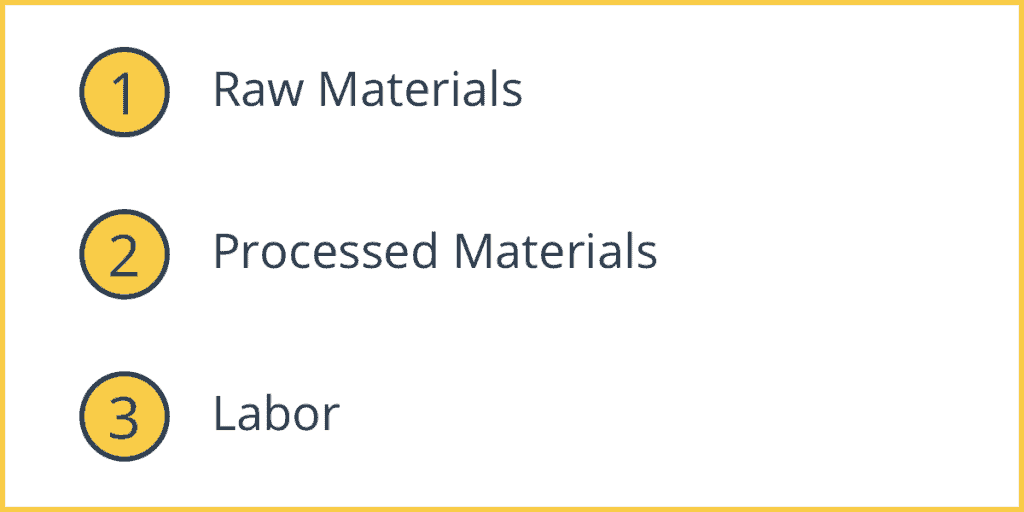The term Derived Demand refers to the demand for a good or service that itself arises out of the demand for a related or intermediate good or service. Thus the dependent demand often has a notable effect on the market price of the derived good.
It’s important to note the difference between regular demand and derived demand. Regular demand is much more straightforward–it’s just the amount of a good or service that customers are willing to buy at a given moment.
Components of Derived Demand
As a concept, derived demand incorporates three key components:
- Raw materials
- Processed materials
- Labor
These three components form the chain of derived demand. Raw materials become processed materials, which are turned into marketable products through labor and then purchased by consumers. Consumer demand for a product impels the production and/or harvest of the raw materials that make up that good.
Defining These Three Components

1. Raw Materials
Raw materials are those primary, unprocessed products used for the production of goods. They may also be referred to as “commodities” in some instances. For example, unprocessed wool is a type of raw material, as is crude oil.
2. Processed Materials
Processed materials are those that have taken the raw materials and created new goods using them. For instance, in the case of unprocessed wool, it becomes a processed material when it is cleaned, dyed, and made into yarn. And crude oil is processed into gasoline and other kinds of petroleum products.
3. Labor
Labor is the work done by workers either to create goods or to offer services. Labor is a component of derived demand because the demand for labor varies based on the demand for the goods or services that labor produces. There is no inherent demand for labor or for a workforce of any kind without the demand for the goods and services provided by labor.
Indirect Derived Demand
There are both direct and indirect forms of derived demand. Direct derived demand typically affects things like the raw materials that make up the good that’s in regular demand (see the definition of this concept above, under “Derived Demand Definition”). But derived demand can also arise indirectly. This would include the goods and services needed to produce and sell the item in direct demand, such as energy to power its production and stores to sell the product.
Derived Demand Example
If you’re asked “Which of the following is an example of derived demand?” you’ll need to know how to identify a case of derived demand when you see it. Here are a few useful examples to help you understand the concept more clearly in practice.
For example, the demand for electric guitars creates a derived demand for amplifiers and guitar picks, since you’ll probably need both to play your guitar once you purchase it. It will also create some demand for guitar lessons, for those who purchase their guitar and then need to learn to play it.
Another example might be that of transport. People typically take buses or other public transport in order to get to their place of employment. That is, people don’t usually take public transport simply to enjoy the ride. This means that demand for these types of functional transportation is dependent on the demand for those services provided by the workers using this transportation, or by their own demand for other goods/services that they need to access by traveling. It’s easy to see how the ripple effect of the chain of derived demand can be extremely complex and wide-ranging.
And here’s another example, one that showcases the three key components of derived demand: raw materials, processed materials, and labor. In the case of custom-made bookshelves (for instance), the first step is the raw materials: that might be wood harvested from a forest, the demand for which was created by the customer’s demand for a wooden bookshelf. Then there are the processed materials: the wood is processed so that it is ready to be used to build a shelf. Finally, there’s the labor: labor goes into using the processed wood to build the shelf, which is finally ready to go to the consumer.
The Economic Effects of Derived Demand
The chain of derived demand has an enormous effect on economies on small as well as large scales. For instance, on a national or international scale, greater demand for raw materials may lead to the creation of new trading markets in countries that have those raw materials among their natural resources.
Not All Situations Create Significant Derived Demand
Sometimes derived demand for, say, raw materials does not change significantly as a result of changes in demand for a given product. This is especially true for items that are made of very widely used raw materials, such as wool for sweaters. If wool sweaters of a certain style become fashionable for a year, and then become less fashionable soon after, this isn’t likely to meaningfully impact the overall demand for wool.

